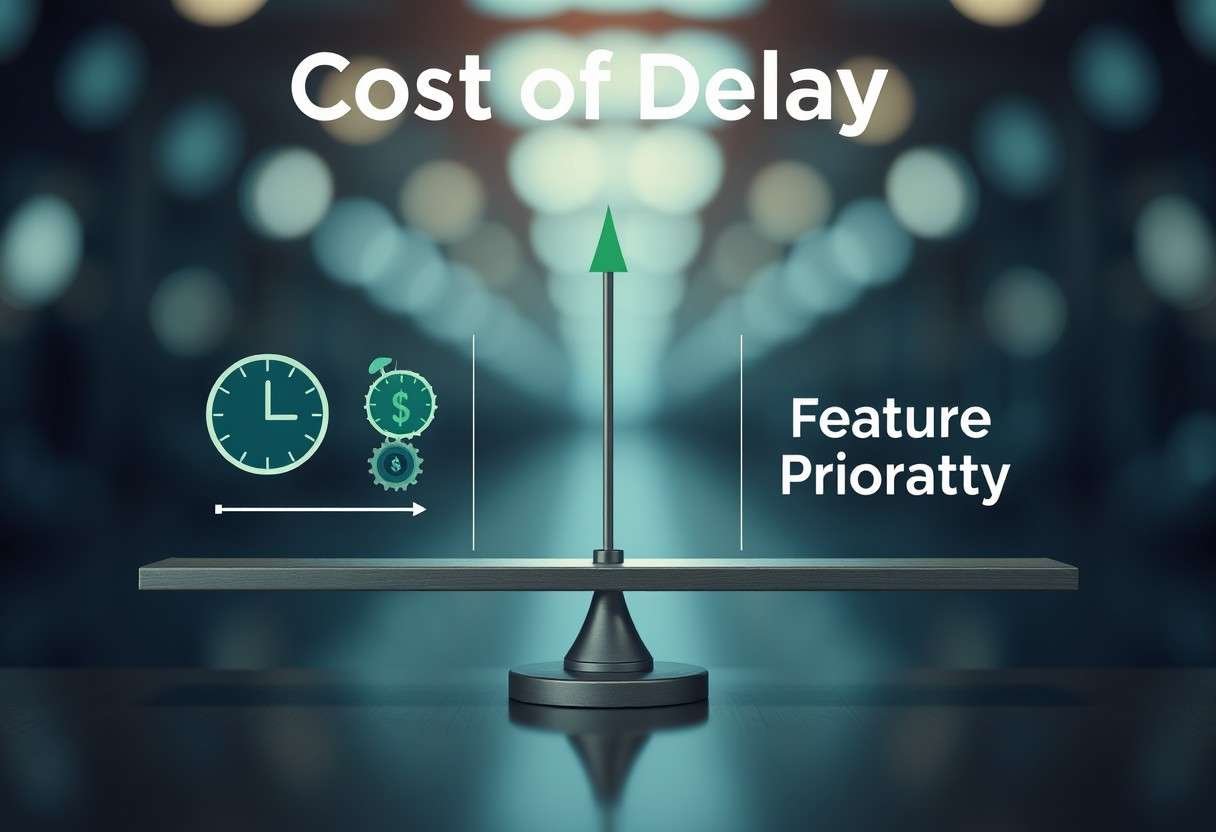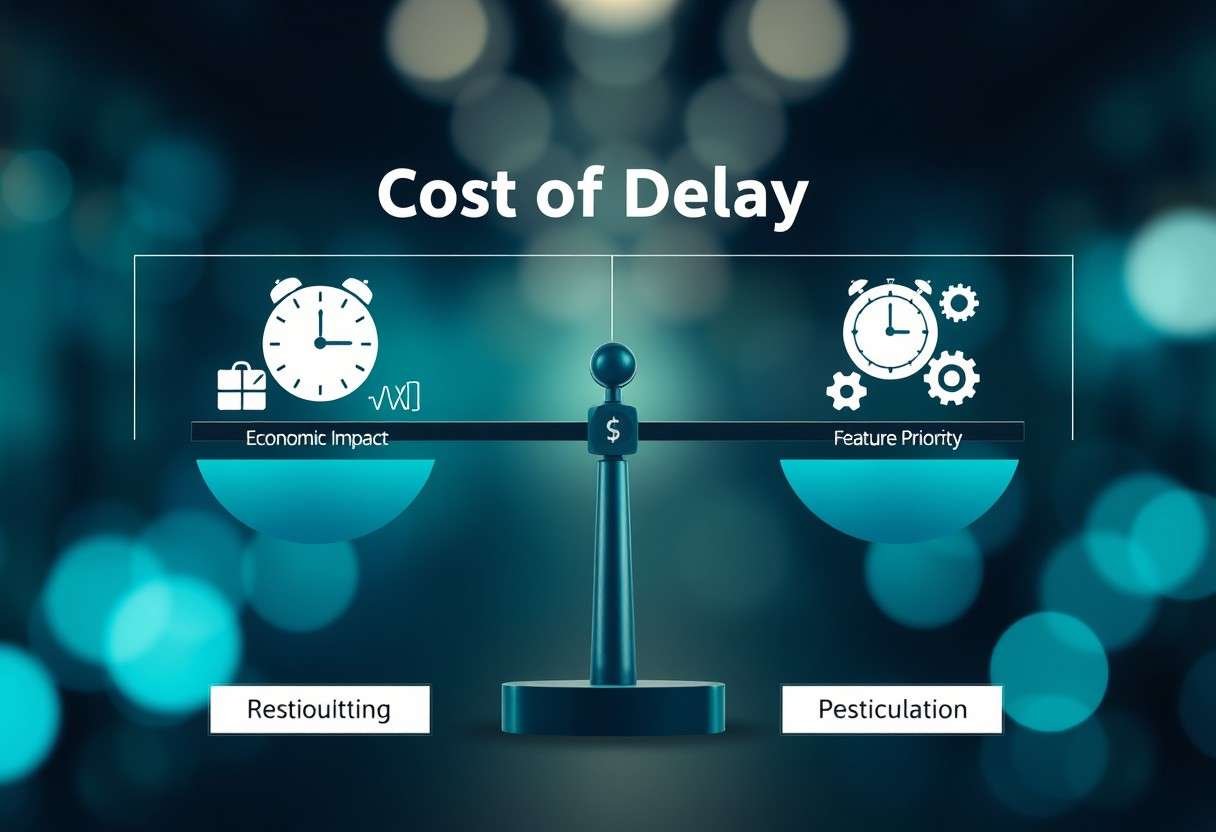Many businesses struggle with the complex task of prioritizing features in product development, often leading to wasted resources and missed opportunities. Understanding the Cost of Delay (CoD) can be a game-changer for you, allowing you to evaluate the economic impact of your decisions effectively. In this post, you will learn how to assess CoD and use it to make informed choices about which features to prioritize, ultimately maximizing your team’s productivity and ensuring that you deliver the most value to your customers.
Key Takeaways:
- Cost of Delay (CoD) is a crucial metric that helps organizations assess the economic impact of delaying the release of features, enabling prioritization based on potential revenue loss or additional costs incurred.
- Understanding the economic impact of features involves calculating both the value of the feature and the impact of timing, allowing teams to make informed decisions about which features to deliver first.
- Using CoD effectively requires a collaborative approach, integrating insights from various stakeholders to align on priorities and ensure that development efforts are focused on high-impact features.
Understanding Cost of Delay
Definition of Cost of Delay
The Cost of Delay (CoD) is a concept that quantifies the financial impact of delaying a project or feature launch. Essentially, it measures the potential revenue loss, missed opportunities, and increased costs associated with postponing a decision or action. When you understand the CoD, you can better assess the urgency of different features in your product roadmap, enabling you to make more informed prioritization decisions that align with your strategic goals.
In practical terms, the CoD is often calculated by evaluating the expected financial benefit of a feature and comparing it to the estimated time it will take to deliver that feature. This metric allows you to capture the economic impact of delays and provides a clearer picture of where to allocate your resources effectively. By grasping this concept, you can shift your focus from simply completing tasks to maximizing your organization’s overall value creation.
Importance of Cost of Delay in Decision Making
Delay in delivering features can significantly diminish your organization’s competitive edge, which is why understanding CoD is imperative in your decision-making process. By applying this metric, you can prioritize tasks based on their economic impact rather than just urgency or perceived importance. This approach leads to enhanced productivity and efficiency, ultimately benefiting your bottom line.
Moreover, recognizing the CoD allows you to foster discussions around prioritization among team members and stakeholders. When everyone is operating with a shared understanding of the financial implications of delays, it promotes transparency and increases collaboration. As a result, those discussions lead to better strategic alignment on what features truly matter to your customers and your business.
Common Misconceptions about Cost of Delay
Making decisions based on the Cost of Delay can sometimes be misleading due to its various misconceptions. One common myth is that it only applies to large-scale projects or products; however, CoD is relevant to all feature releases, regardless of size. You should not overlook smaller projects, as their cumulative delays can have a significant economic impact over time.
Additionally, many believe that CoD is exclusively tied to tangible financial losses. In reality, it also encompasses other aspects such as brand reputation, customer satisfaction, and future business opportunities. By recognizing this broader perspective, you can leverage CoD to enhance your understanding of the overall impact of decision-making within your organization.
Cost considerations should never be the only factor in decision-making. However, ignoring the Cost of Delay can put your organization at a significant disadvantage. By understanding CoD, you equip yourself with a valuable tool that ensures you make informed, economically sound choices that drive your success.
How to Calculate Cost of Delay
If you’re looking to enhance your product management strategy, understanding how to calculate Cost of Delay (CoD) is imperative. CoD not only helps you quantify the impact of delaying features but also aids in prioritizing them based on their economic implications. To get deeper insights, you might find this resource helpful: Cost of Delay Analysis – What, Why and How for Product ….
Identifying Relevant Metrics
Cost is not just about money; it encompasses several metrics that can affect your decision-making process. Start by identifying key performance indicators (KPIs) relevant to your specific product and market. These may include metrics such as revenue generation, customer acquisition costs, or even user engagement statistics. By pinpointing the most relevant metrics, you can lay a solid foundation for evaluating the potential cost associated with delays. Consider how different features may impact various KPIs to understand the broader implications of your priorities.
Your metrics should ideally reflect the value that each feature offers to your customers and the business. This means not only looking at immediate financial gains but also considering long-term benefits and strategic positioning. The closer your selected metrics align with your overarching business goals, the more accurately you can assess the cost of delaying certain features.
Creating a Cost of Delay Formula
Formula creation is a crucial step in quantifying the Cost of Delay. Start by defining your formula components clearly: it typically factors in the potential revenue lost, the urgency of delivering the feature, and the time that will be required to implement it. The basic formula could look something like this: Cost of Delay = (Revenue Impact per Time Unit) x (Time Delay). This simplified version can be further refined based on your specific context and metrics.
The more precise you can be in calculating your input variables, the more reliable your Cost of Delay figure will be. Aim to capture data in real-time and adjust your formula as necessary to reflect changing market conditions and stakeholder needs. Regularly revisiting your formula will allow you to create a more adaptive framework, better positioning your team for success.
Plus, don’t overlook the importance of stakeholder collaboration when forming your Cost of Delay formula. Engage your team members from various departments, such as marketing, sales, and finance, to gather input. Their insights will help ensure that your formula encompasses multiple facets of delay impact and leads to more informed prioritization decisions.
Tools and Methods for Calculation
Tools of the trade can significantly aid you in your Cost of Delay calculations. Consider using specialized software or templates designed for product management that allow you to input predefined metrics and track delays in real-time. These tools simplify the data collection process and enhance collaboration within your team, leading to more effective prioritization. You might also explore Kanban boards or agile project management tools that provide visual cues for delays and their potential impacts.
It’s worth mentioning that while tools can facilitate your calculations, it’s imperative to ensure that your team is trained to interpret and utilize the data effectively. High-quality analysis relies on both the tools at your disposal and the insights of your team members. Bear in mind, the goal is to create a system that not only calculates the Cost of Delay but also ultimately drives faster, smarter decisions for your product roadmap.

Factors Affecting Cost of Delay
Your ability to accurately assess the Cost of Delay (CoD) is crucial for effective feature prioritization. Understanding the various factors that contribute to this cost will help you make informed decisions about which features to develop first. Here are some key factors that can significantly impact CoD:
- Market Demand
- Competitive Landscape
- Project Time Sensitivity
- Resource Availability
Market Demand and Customer Value
Clearly, the market demand and customer value of a feature play a significant role in determining its Cost of Delay. If a feature is highly requested by your customers, delaying its development can lead to lost revenue and diminished customer satisfaction. Therefore, understanding customer needs and aligning them with your product strategy is vital for maximizing value and ensuring a positive impact on your bottom line.
Additionally, the economic impact of delaying a feature should be evaluated. A feature that significantly enhances customer experience or operational efficiency can justify its priority over others. This analysis not only aids in prioritization but also helps you understand the trade-offs involved in feature development. For more detailed insights, consider exploring Cost Of Delay Analysis: Tips for Product Managers.
Competitive Landscape
Now, the competitive landscape can also critically affect the Cost of Delay. If your competitors are rapidly rolling out features that meet customer needs, delaying your own feature could mean losing market share or falling behind in terms of product relevance. By being aware of your competitors’ actions and market trends, you can better assess the implications of adding delays to your delivery timeline.
Moreover, having a finger on the pulse of the competitive environment allows you to strategically prioritize features that can deliver a more compelling offering compared to your peers. This not only minimizes the risk of being outperformed but also enhances your position in the market.
For instance, if a competitor launches a feature that attracts significant interest, the pressure on you to develop a similar or superior feature intensifies. Delaying your response could lead to a more substantial loss in user engagement and loyalty, ultimately inflating your Cost of Delay.
Project Time Sensitivity
An important aspect to consider is project time sensitivity. Certain features may become more critical to deliver at specific times, such as during seasonal demand spikes or product launches. The delays in these cases can not only risk missing key market opportunities but also incur additional costs as a result of lost sales and decreased customer satisfaction.
Furthermore, understanding the timelines associated with your projects can help you prioritize efficiently. If a feature is tied to a current event or trend that is time-sensitive, it becomes clear that the Cost of Delay is heightened. You need to be agile in your decision-making to capitalize on fleeting opportunities.
A clear timeline helps you align your resources and development schedules, ensuring that you respond to market needs swiftly and effectively.
Resource Availability
Some factors that directly tie into resource availability include team capacity, skill sets, and time constraints. If your team lacks the necessary resources to develop a feature within the desired timeframe, the Cost of Delay may increase significantly. Effectively managing your workforce and capabilities can often determine your advocacy for certain features over others.
Additionally, having the right resources in place enables you to minimize delays and respond timely to emerging customer demands. Diversifying your skill sets within your team can also further mitigate risks associated with resource limitations.
Resource allocation must be continually assessed to ensure you’re maximizing efficiency and minimizing delays based on availability.
Prioritizing Features Based on Economic Impact
Now, prioritizing features effectively is crucial for maximizing your team’s productivity and ensuring your project delivers the intended value. One key approach is to understand the economic impact of each feature you are considering. This allows you to make informed decisions about which features to prioritize based on their potential contribution to your overall business goals. By assessing the Cost of Delay associated with each feature, you can determine the urgency of each project and how it aligns with your organization’s objectives.
Establishing Business Objectives
Assuming you have a clear set of business objectives, the first step in prioritizing features is to align them with these goals. Your objectives might include increasing revenue, enhancing customer satisfaction, or reducing operational costs. By establishing these clear directives, you provide a framework that can guide your decision-making process. This means evaluating each feature not just on its own merits but in the context of how effectively it will help meet these broader organizational aims.
Additionally, it’s important to ensure that your business objectives are well-communicated across your organization. Doing so helps every team member understand the overall vision and encourages them to contribute ideas on how to align features with the company’s strategic direction. When you all pull in the same direction, your ability to prioritize effectively increases exponentially.
Aligning Features with Strategic Goals
With a clear understanding of your business objectives, the next step involves aligning features with these strategic goals. Each feature should be assessed not only for its standalone value but also for how it supports your overarching mission. By mapping out how each feature aligns with specific goals, you can identify which features carry more weight in terms of potential business impact.
Based on this alignment, you can create a prioritization matrix that highlights the most impactful features. This can involve visual tools that categorize features into different levels of importance, helping you to easily see which ones line up with your strategic initiatives. Your decisions on what to prioritize will be strengthened by this alignment, enabling a more strategic use of your resources.
Using Cost of Delay to Rank Features
Using the Cost of Delay (CoD) as a metric enables you to rank features based on their economic impact. By calculating the potential revenue loss, customer dissatisfaction, or other downstream effects that could occur if a feature is delayed, you begin to see a clearer picture of what needs immediate attention. Features with a high Cost of Delay should rightly take precedence over others that may have lower urgency.
This process involves assessing not just the direct benefits of a feature but also the potential costs associated with delaying its implementation. Consideration of factors such as market competition, customer demands, and seasonal influences can further amplify your decision-making process, ensuring you are not just reacting but proactively optimizing the timing of your releases.
Tips for Effective Feature Prioritization
To effectively prioritize features based on economic impact, you can leverage a few key strategies. Implementing the Cost of Delay approach is crucial in your decision-making process. Here are some tips that can guide you:
- Consider the economic value each feature brings.
- Engage with stakeholders to align priorities with business goals.
- Balance between short-term wins and long-term strategy.
- Regularly reassess priorities to adapt to changing circumstances.
Recognizing the importance of each of these elements will ensure that you maintain a focused and pragmatic approach to feature prioritization, helping to maximize your team’s productivity and overall project success. For a deeper explore the Cost of Delay Prioritization Framework: Definition & Benefits, make sure to explore additional resources.
Engaging Stakeholders in the Process
The involvement of your stakeholders in the prioritization process is vital for achieving success. By actively engaging those who are affected by your product and their needs, you can gather diverse insights and feedback, helping you to identify features that carry the most weight in terms of impact. This collaborative approach fosters a sense of ownership, leading to better alignment and support across your team.
Additionally, consider setting up regular stakeholder meetings or workshops to facilitate discussions surrounding priorities. This not only allows you to measure their perception of urgency but also enables you to cultivate a transparent environment where everyone feels valued in their contributions. Such an inclusive approach ensures that your final list of priorities accurately reflects both business objectives and user needs.
Balancing Short-term and Long-term Goals
One of the main challenges in feature prioritization is finding the right balance between short-term and long-term goals. While it might be tempting to focus solely on quick wins that deliver immediate benefits, neglecting long-term objectives can lead to missed opportunities for growth and development. To optimize your feature roadmap, ensure you allocate resources to both immediate improvements and strategic initiatives that will propel your product forward.
It’s crucial to assess the potential impact of each feature through both lenses—what solves an immediate problem and what lays the groundwork for future advancements. Striking this balance can result in sustainable product development that not only satisfies current user demands but also positions your product competitively in the marketplace.
Long-term thinking encourages a commitment to innovation and improvement over time. By understanding how your short-term decisions will influence your product’s trajectory, you can make informed choices that benefit your organization in the long run.
Regularly Reassessing Priorities
Prioritization is not a one-time event; it demands continuous evaluation to stay relevant amidst changing market conditions. As aspects such as user feedback, business objectives, and competitive landscape evolve, you should routinely reassess your priorities and be willing to pivot as necessary. This iterative process helps you to remain agile and responsive to new challenges and opportunities, ultimately leading to better product outcomes.
By hosting recurring review sessions, you create a structured environment to analyze the effectiveness of your decisions. Gathering data on the performance and impact of released features can provide you valuable insights for future prioritization. This proactive approach not only mitigates risks but also enhances your team’s capacity to adapt to unforeseen circumstances.
Balancing your priorities between existing features and future potential is necessary for long-term product success. Implementing a cadence for reassessing your feature priorities ensures that you are always aligned with your strategic goals and focused on delivering maximum value to your users and stakeholders.
How to Communicate Cost of Delay to Team Members
Many teams struggle to understand the concept of Cost of Delay (CoD) and how it affects their decision-making process. To effectively communicate CoD to your team members, it’s necessary to break down complex economic concepts into clear, digestible information. The more your team understands the financial implications of their work, the more motivated and aligned they will be in prioritizing critical features. By creating a shared understanding of how delay impacts various aspects of the business, your team can make faster, more informed decisions.
Presenting Clear Data and Visuals
Delay in delivering features can result in substantial losses for the company, making it crucial to present clear data and visuals that illustrate this impact. Using charts, graphs, and other visual aids can help highlight how costs accumulate over time, allowing your team members to visualize the implications of delaying certain features. Data representation should include metrics such as potential revenue losses, customer dissatisfaction, or the opportunity costs associated with your project timelines.
Visual storytelling can engage your audience and resonate on a personal level. Consider sharing real-life case studies or examples that show the direct correlation between delay and financial impact. When team members see tangible evidence of how a delayed feature contributes to revenue loss or customer attrition, they are more likely to grasp the urgency of prioritizing that work.
Demonstrating the Economic Impact of Decisions
Members of your team may have varying levels of understanding when it comes to economic principles, so it is necessary to clarify how their specific decisions influence the overall financial health of the organization. When you illustrate the economic impact of delayed implementation and how it translates into actual dollars, it helps team members appreciate the stakes of their choices. Utilize examples they can relate to, where possible, to illustrate this economic impact clearly.
Clear and engaging discussions around these topics can cultivate a sense of responsibility and urgency within your team. Encourage team members to consider the broader financial implications of their tasks and to engage in analyses that quantify the impact of their work. By tying their daily responsibilities to the overarching goals of the business, team members will feel a sense of ownership and commitment to reducing delays.
Fostering a Culture of Prioritization
Economic viability should be at the forefront of your team’s decision-making process. When you foster a culture of prioritization, your team learns to weigh features not just on complexity or time required, but also on their potential economic impact. This pivot in outlook encourages team members to advocate for high-impact features while understanding the cost of delays in their development.
Creating an environment where prioritization is valued will encourage constant evaluation of projects, leading to better alignment with business goals. Regularly communicate how prioritization influences the company’s bottom line and share updates on the results being achieved through timely deliveries. The ongoing dialogue about economic impact will reinforce its importance, enabling your team to consistently consider the Cost of Delay as part of their workflow.
The results of fostering a culture of prioritization can have profound effects on overall team performance. When team members are empowered to prioritize economically impactful features, not only do you mitigate delays, but you also drive a higher return on investment for your business solutions. This shift can yield long-term benefits that contribute to the success of your organization.
Summing up
As a reminder, understanding the cost of delay is crucial for effectively prioritizing features that deliver the most significant economic impact to your project. By evaluating how each feature affects your overall business objectives, you empower yourself to make informed decisions that align with your strategic goals. This approach not only helps you prioritize tasks based on urgency and value but also enables you to communicate more convincingly with stakeholders regarding the rationale behind your choices.
Implementing cost of delay analysis in your decision-making processes can transform how you allocate resources and schedule development work. By focusing on the potential revenue losses associated with delaying certain features, you can optimize your project timeline, enhance team productivity, and ultimately drive greater growth for your business. As you apply these principles, you position yourself to not only deliver timely solutions but also maximize the value your features bring to the market.
FAQ
Q: What is Cost of Delay and why is it important in feature prioritization?
A: Cost of Delay (CoD) refers to the economic impact of delaying a project or feature implementation. It quantifies the potential revenue loss or missed opportunities that arise as a result of not delivering a feature on time. Understanding CoD is crucial in feature prioritization because it helps teams make informed decisions about which features to develop first based on their potential economic benefits. By focusing on features with a high CoD, organizations can maximize their returns on investment and drive better business outcomes.
Q: How can teams calculate the Cost of Delay for different features?
A: To calculate the Cost of Delay, teams can use a formula that considers three primary components: value, urgency, and risk of loss. First, they assess the potential value provided by the feature (e.g., revenue generation, cost savings). Next, they determine how urgent the feature is by evaluating the expected time frame for its impact. Finally, they consider the risk factor, which includes market competition and the likelihood of feature obsolescence. By combining these factors, teams can assign a CoD metric to each feature, helping them prioritize effectively based on economic impact.
Q: What are some common challenges when using Cost of Delay in prioritization processes?
A: Common challenges in using Cost of Delay for prioritization include estimating values accurately, recognizing dependencies among features, and accounting for changing market conditions. Teams may struggle to assign a definitive economic value to certain features, especially if they involve intangible benefits. Additionally, delays in one feature can have a ripple effect on others, complicating the CoD calculations. Lastly, external factors such as market trends and competitor actions can alter the urgency and value of a feature, requiring teams to regularly reassess their priorities to stay aligned with their strategy.







